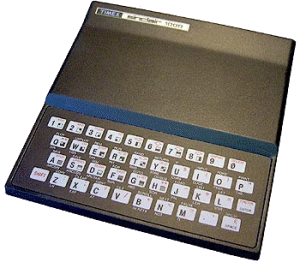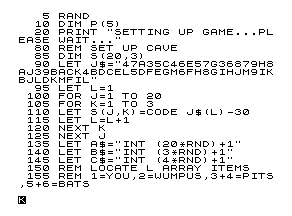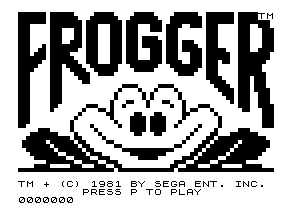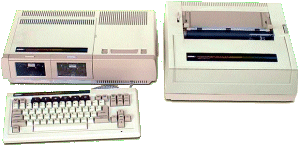Another
part of the videogaming phenomenon of the early 1980s centered
around being able to own a personal computer system, since with
them you could not only play videogames but you could also
program your own on them. Of course, there were very few who
could own personal computers since most of them were still in the
$300-plus price range. And even for those who could, very few
could know how to use machine language in order to create the
same (or similar) awesome games that could be played on a regular
videogame system at the time. Fortunately, there were books
featuring a vast number of different game programs that could be
typed in using a programming language called BASIC (Beginner's
All-Purpose Symbolic Instruction Code) so others could possibly
learn from them how to create their own games, however simplified
they may be from those done in machine language.
 Of the computers I have owned or have played with, the one that totally deserves
any mention from me would be the Timex Sinclair 1000.
This notebook-sized computer, which my father bought for
the family in 1982 following getting the Atari 2600 as a
Christmas present, was a wonderful learning tool that got
me interested in learning how to program games. Not that
this was the first computer that piqued an interest in me
in doing so -- the honors for that go to Radio Shack's
TRS-80 Model 1, a black-and-white personal computer that
found most of its homes on business and school desktops --
but the Timex Sinclair was one of
the few among those that sold for $100, a price that made
owning a personal computer attractive for the person or
families that wanted to own a computer but couldn't
afford the pricetag on things like the TRS-80 type
computers.
Of the computers I have owned or have played with, the one that totally deserves
any mention from me would be the Timex Sinclair 1000.
This notebook-sized computer, which my father bought for
the family in 1982 following getting the Atari 2600 as a
Christmas present, was a wonderful learning tool that got
me interested in learning how to program games. Not that
this was the first computer that piqued an interest in me
in doing so -- the honors for that go to Radio Shack's
TRS-80 Model 1, a black-and-white personal computer that
found most of its homes on business and school desktops --
but the Timex Sinclair was one of
the few among those that sold for $100, a price that made
owning a personal computer attractive for the person or
families that wanted to own a computer but couldn't
afford the pricetag on things like the TRS-80 type
computers.
 Granted, the Timex Sinclair 1000 was very limited as far as capabilities for personal computers at that time period went. It had no more than 2,000 bytes of memory for program storage, which could be extended to 16K or even 32K. It had black-and-white graphics which were very blocky at best. It had no sound capabilities for either music or sound effects. It had a flat membrane keyboard that is so small that only kids could use it without any problem. And it also required an ordinary cassette recorder to save and load programs. What it did have, despite its shortcomings, was an easy-to-learn version of BASIC that, given time and some good books on programming the Timex Sinclair 1000, would allow a user to learn how to develop his or her own programs,including games. This is just a mere sample of what a BASIC program on the Timex Sinclair 1000 looks like being listed on the screen.
Granted, the Timex Sinclair 1000 was very limited as far as capabilities for personal computers at that time period went. It had no more than 2,000 bytes of memory for program storage, which could be extended to 16K or even 32K. It had black-and-white graphics which were very blocky at best. It had no sound capabilities for either music or sound effects. It had a flat membrane keyboard that is so small that only kids could use it without any problem. And it also required an ordinary cassette recorder to save and load programs. What it did have, despite its shortcomings, was an easy-to-learn version of BASIC that, given time and some good books on programming the Timex Sinclair 1000, would allow a user to learn how to develop his or her own programs,including games. This is just a mere sample of what a BASIC program on the Timex Sinclair 1000 looks like being listed on the screen.
 As far as preprogrammed
games are concerned, however, that kind of software for
the Timex Sinclair 1000 was hard to find. You would have
to look through special newsletters like Syntax ZX80 (which
covered programming the Sinclair ZX81, the British
version of the Timex Sinclair 1000, and its predecessor,
the Sinclair ZX80) just to find independent vendors that
could provide gaming software, and most of it was on tape.
Timex itself released a few games like Chess, Flight
Simulation, and Frogger, the last one of the three which
my father bought for our Timex Sinclair 1000. It's not a
bad version of the original arcade game, mind you,
considering that because of the big blocky graphics they
had to split up the screen into two screens: the street
screen and the river screen. Still, with the amount of
printed game programs that appeared in books and
newsletters, one could never get bored with the amazing
amount of gameware that otherwise was not readily
available for this small personal computer system.
As far as preprogrammed
games are concerned, however, that kind of software for
the Timex Sinclair 1000 was hard to find. You would have
to look through special newsletters like Syntax ZX80 (which
covered programming the Sinclair ZX81, the British
version of the Timex Sinclair 1000, and its predecessor,
the Sinclair ZX80) just to find independent vendors that
could provide gaming software, and most of it was on tape.
Timex itself released a few games like Chess, Flight
Simulation, and Frogger, the last one of the three which
my father bought for our Timex Sinclair 1000. It's not a
bad version of the original arcade game, mind you,
considering that because of the big blocky graphics they
had to split up the screen into two screens: the street
screen and the river screen. Still, with the amount of
printed game programs that appeared in books and
newsletters, one could never get bored with the amazing
amount of gameware that otherwise was not readily
available for this small personal computer system.
 Unfortunately, a few years later,
the Timex Sinclair 1000 became an unusable personal
computer system, and the books that I have collected for
it became somewhat useless. Around 1985, I had taken the
unexpected plunge into buying the ADAM Family Computer
System, which is basically a ColecoVision with 64K
memory, a modified tape drive that worked with almost the
same speed as a floppy disk drive, a full-stroke
keyboard, a built-in word processor program, and a daisy-wheel
printer that could only print out typewritten text. (The
Timex Sinclair had a printer that could print out
graphics, but it used very small strips of special paper,
and we never bought one for ours.) Its version of BASIC
was better in that it allowed for programming the
ColecoVision game controllers to be used with games
programmed in its BASIC, but even though I did do some
interesting conversions of Timex Sinclair BASIC game
programs on the Coleco ADAM, they could never really
match the black-and-white simplicity that made the
original versions really sing on the computer they were
meant to run on. On the other hand, the ADAM computer was
more suited for the text-style game programs like Eliza (a
really weird psychoanalyst-style conversation game) and
Hunt The Wumpus (an adventure-style game).
Unfortunately, a few years later,
the Timex Sinclair 1000 became an unusable personal
computer system, and the books that I have collected for
it became somewhat useless. Around 1985, I had taken the
unexpected plunge into buying the ADAM Family Computer
System, which is basically a ColecoVision with 64K
memory, a modified tape drive that worked with almost the
same speed as a floppy disk drive, a full-stroke
keyboard, a built-in word processor program, and a daisy-wheel
printer that could only print out typewritten text. (The
Timex Sinclair had a printer that could print out
graphics, but it used very small strips of special paper,
and we never bought one for ours.) Its version of BASIC
was better in that it allowed for programming the
ColecoVision game controllers to be used with games
programmed in its BASIC, but even though I did do some
interesting conversions of Timex Sinclair BASIC game
programs on the Coleco ADAM, they could never really
match the black-and-white simplicity that made the
original versions really sing on the computer they were
meant to run on. On the other hand, the ADAM computer was
more suited for the text-style game programs like Eliza (a
really weird psychoanalyst-style conversation game) and
Hunt The Wumpus (an adventure-style game).
Fortunately,
in the age where even classic personal computer systems are
emulated on a Windows-operating PC or a Macintosh, whichever you
happen to own, all is not entirely lost for the tiny little
computer system that could. There are at least a few good
emulators for the Timex Sinclair 1000, including one called (what
else?) the ZX81. If you ever wanted to see how fast your existing
computer can run Timex Sinclair software, ZX81 does the best job
there is in doing that -- it can run in either normal processing
speed (meaning normal in the days of the Timex Sinclair 1000) or
turbo speed, all at the press of the plus sign keypad key.
Another good emulator of that system is the NO$ZX81 (meaning
"no cash", as in freeware), which lets you toggle
between the normal operating system and the debugger mode, which
lets you set up how you want the emulator to run, including
reversed color video mode (black background with white characters
instead of a white background with black characters).
Gameware can be found wherever there are Timex Sinclair/ZX81 emulator sites (copyright problems are almost nonexistent in this case since the majority of programs you can find are typed up from
books and newsletters). The quality of most of these games fall
probably along the level of even the less interesting of Atari
2600 software, which is a mild way of stating it, but there are
some real gems to be found.
 Of the computers I have owned or have played with, the one that totally deserves
any mention from me would be the Timex Sinclair 1000.
This notebook-sized computer, which my father bought for
the family in 1982 following getting the Atari 2600 as a
Christmas present, was a wonderful learning tool that got
me interested in learning how to program games. Not that
this was the first computer that piqued an interest in me
in doing so -- the honors for that go to Radio Shack's
TRS-80 Model 1, a black-and-white personal computer that
found most of its homes on business and school desktops --
but the Timex Sinclair was one of
the few among those that sold for $100, a price that made
owning a personal computer attractive for the person or
families that wanted to own a computer but couldn't
afford the pricetag on things like the TRS-80 type
computers.
Of the computers I have owned or have played with, the one that totally deserves
any mention from me would be the Timex Sinclair 1000.
This notebook-sized computer, which my father bought for
the family in 1982 following getting the Atari 2600 as a
Christmas present, was a wonderful learning tool that got
me interested in learning how to program games. Not that
this was the first computer that piqued an interest in me
in doing so -- the honors for that go to Radio Shack's
TRS-80 Model 1, a black-and-white personal computer that
found most of its homes on business and school desktops --
but the Timex Sinclair was one of
the few among those that sold for $100, a price that made
owning a personal computer attractive for the person or
families that wanted to own a computer but couldn't
afford the pricetag on things like the TRS-80 type
computers. Granted, the Timex Sinclair 1000 was very limited as far as capabilities for personal computers at that time period went. It had no more than 2,000 bytes of memory for program storage, which could be extended to 16K or even 32K. It had black-and-white graphics which were very blocky at best. It had no sound capabilities for either music or sound effects. It had a flat membrane keyboard that is so small that only kids could use it without any problem. And it also required an ordinary cassette recorder to save and load programs. What it did have, despite its shortcomings, was an easy-to-learn version of BASIC that, given time and some good books on programming the Timex Sinclair 1000, would allow a user to learn how to develop his or her own programs,including games. This is just a mere sample of what a BASIC program on the Timex Sinclair 1000 looks like being listed on the screen.
Granted, the Timex Sinclair 1000 was very limited as far as capabilities for personal computers at that time period went. It had no more than 2,000 bytes of memory for program storage, which could be extended to 16K or even 32K. It had black-and-white graphics which were very blocky at best. It had no sound capabilities for either music or sound effects. It had a flat membrane keyboard that is so small that only kids could use it without any problem. And it also required an ordinary cassette recorder to save and load programs. What it did have, despite its shortcomings, was an easy-to-learn version of BASIC that, given time and some good books on programming the Timex Sinclair 1000, would allow a user to learn how to develop his or her own programs,including games. This is just a mere sample of what a BASIC program on the Timex Sinclair 1000 looks like being listed on the screen. As far as preprogrammed
games are concerned, however, that kind of software for
the Timex Sinclair 1000 was hard to find. You would have
to look through special newsletters like Syntax ZX80 (which
covered programming the Sinclair ZX81, the British
version of the Timex Sinclair 1000, and its predecessor,
the Sinclair ZX80) just to find independent vendors that
could provide gaming software, and most of it was on tape.
Timex itself released a few games like Chess, Flight
Simulation, and Frogger, the last one of the three which
my father bought for our Timex Sinclair 1000. It's not a
bad version of the original arcade game, mind you,
considering that because of the big blocky graphics they
had to split up the screen into two screens: the street
screen and the river screen. Still, with the amount of
printed game programs that appeared in books and
newsletters, one could never get bored with the amazing
amount of gameware that otherwise was not readily
available for this small personal computer system.
As far as preprogrammed
games are concerned, however, that kind of software for
the Timex Sinclair 1000 was hard to find. You would have
to look through special newsletters like Syntax ZX80 (which
covered programming the Sinclair ZX81, the British
version of the Timex Sinclair 1000, and its predecessor,
the Sinclair ZX80) just to find independent vendors that
could provide gaming software, and most of it was on tape.
Timex itself released a few games like Chess, Flight
Simulation, and Frogger, the last one of the three which
my father bought for our Timex Sinclair 1000. It's not a
bad version of the original arcade game, mind you,
considering that because of the big blocky graphics they
had to split up the screen into two screens: the street
screen and the river screen. Still, with the amount of
printed game programs that appeared in books and
newsletters, one could never get bored with the amazing
amount of gameware that otherwise was not readily
available for this small personal computer system. Unfortunately, a few years later,
the Timex Sinclair 1000 became an unusable personal
computer system, and the books that I have collected for
it became somewhat useless. Around 1985, I had taken the
unexpected plunge into buying the ADAM Family Computer
System, which is basically a ColecoVision with 64K
memory, a modified tape drive that worked with almost the
same speed as a floppy disk drive, a full-stroke
keyboard, a built-in word processor program, and a daisy-wheel
printer that could only print out typewritten text. (The
Timex Sinclair had a printer that could print out
graphics, but it used very small strips of special paper,
and we never bought one for ours.) Its version of BASIC
was better in that it allowed for programming the
ColecoVision game controllers to be used with games
programmed in its BASIC, but even though I did do some
interesting conversions of Timex Sinclair BASIC game
programs on the Coleco ADAM, they could never really
match the black-and-white simplicity that made the
original versions really sing on the computer they were
meant to run on. On the other hand, the ADAM computer was
more suited for the text-style game programs like Eliza (a
really weird psychoanalyst-style conversation game) and
Hunt The Wumpus (an adventure-style game).
Unfortunately, a few years later,
the Timex Sinclair 1000 became an unusable personal
computer system, and the books that I have collected for
it became somewhat useless. Around 1985, I had taken the
unexpected plunge into buying the ADAM Family Computer
System, which is basically a ColecoVision with 64K
memory, a modified tape drive that worked with almost the
same speed as a floppy disk drive, a full-stroke
keyboard, a built-in word processor program, and a daisy-wheel
printer that could only print out typewritten text. (The
Timex Sinclair had a printer that could print out
graphics, but it used very small strips of special paper,
and we never bought one for ours.) Its version of BASIC
was better in that it allowed for programming the
ColecoVision game controllers to be used with games
programmed in its BASIC, but even though I did do some
interesting conversions of Timex Sinclair BASIC game
programs on the Coleco ADAM, they could never really
match the black-and-white simplicity that made the
original versions really sing on the computer they were
meant to run on. On the other hand, the ADAM computer was
more suited for the text-style game programs like Eliza (a
really weird psychoanalyst-style conversation game) and
Hunt The Wumpus (an adventure-style game).